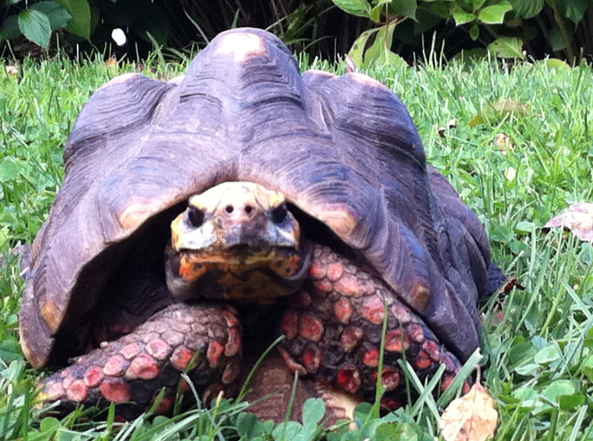Finding A Giant Tortoise Hiding In The Bushes

We have, living in our house in East Hampton, a 10-pound, plant eating South American red legged tortoise. He was not my idea. Twenty-five years ago, when he was about the size of a silver dollar and weighed maybe six ounces, a local environmentalist named Andy Sabin returned from South America and gave this creature to the 7-year-old son of the woman who is now my wife.
The woman who is now my wife told her son Ben to name him.
“Dribble,” he said. Dribble was the name of a tortoise in a children’s book Ben was reading. That was that. [expand]
After that, without me present, Dribble grew and grew to be a, uh, man. Then the woman who is now my wife met me and we got together. That was 10 years ago.
I was introduced to Dribble. He did then and he has now a hard, shiny shell with giant lumps on the top of it. He has a lizard’s face, with expressionless eyes. He can blink. And he can open his mouth pretty wide when he wants to do that. It’s a slow business. Takes him a while. He shows his tiny, wiggly tongue, but no teeth. He has dragon legs with red stripes on them. He has two toes at the end of each. There’s black toenails.
Here are the ways of Dribble. During the night, he lives in a large, empty glass fish tank that is warmed with an electric pad. To simulate the sheltering leaves of the amazon, newspaper is gently placed over him. Then vegetables—cucumbers, watermelon, red peppers, broccoli—are placed on a plastic tray and set down between his front paws. Some nights he eats it. Some nights he doesn’t. Some mornings you just come upon him asleep in it.
Around 9 a.m., a warm bath is made for Dribble in a rectangular Rubbermaid tub, which gets placed on the floor in the kitchen. The water is just three inches deep—a pond in the jungle—and you just lower him straight down into it, plop. He splashes around. Then he poops in the water. After that, you take him out of the bath, empty the tub, and let him, uh, run around the house for the rest of the day. I found his running around the house very disconcerting.
I’d be lying on the sofa in the living room reading and this piece of furniture, something like a small hassock, would glide silently over and sort of bump into my shoes there on the floor. The mouth would not open. He knew this was not food. Then he’d move on. I never got the feeling in those early days that he had come over out of curiosity or anything. He’d just come over. I just happened to be there. At the start of this article, I did not say we had a tortoise as part of the family. I said we had a tortoise living in our house. There is a difference.
This routine never changes, day after day. He seems not to look forward to any of it and he seems not to object to any of it, although I am told that this is about as well as we can simulate the deep jungle of the Amazon in Brazil where he’s from. He will live for another 100 years, a moving defensive fortress extraordinaire, turning into an impregnable rock when danger approaches. I am jealous that he will outlive me. It is very weird.
I will say, in all the 10 years, I have never deliberately put my finger in his mouth. He eats only leaves and vegetables. He has no teeth. But I don’t trust him. What if he made a mistake?
The only time I have even the slightest inkling that he notices me in the house is in the springtime for a couple of weeks. If I come in the front door and I am the only person there (besides Dribble), he will amble over to me. If I sit in a chair and take off my shoes, he will follow me to the chair. He will then crawl over my shoes. And if I move to another chair he will follow me there.
I did think when this first happened that; just perhaps, he was experiencing a learning curve. He was getting fond of me. I mentioned this phenomenon to my wife one day.
“It’s mating season,” she said.
We have a stone statue of a tortoise, just about Dribble’s size, by the front door. I was watching T.V. one evening that spring when out of the corner of my eye I saw him sneaking up on it from behind, something he had never done before. Then he climbed up its back and, uh, smiled.
That’s how I know he is a he. I think.
When the weather turns warm in June and then hot in July and August, as it is in the Amazon all year around down there by the equator, Dribble is taken out into his pasture. This is a grassy area between the front deck and a fence along the street that is about 60 by 100 feet in size and along it’s borders, filled with plants and flowers. Every year we bring in more plants and flowers. It’s the Amazon as best as we can duplicate it. Dribble’s world. He will lurk in the shade under the foliage canopy. (A two-foot high foliage canopy.) Or he will come out into the hot sunshine and stride along in great, manly strides at about a mile an hour, which in tortoise speed is up around 100 and about double his usual pace.
I consider that Dribble, in this way, is showing emotion. It’s his version of a seven-year-old girl skipping along. Sort of.
Then, just this summer, I noticed still further new behavior. In the house, when you’d pick him up, always lifting him on the sides like a tote box, from above and from the rear so you don’t have to face those massive jaws, he would stretch himself out from his shell to his fullest length, in a sort of trusting way that seems to say I know where I’m going. I’m going out into the sunshine. In fact, he would be right about that.
But outside, in the Amazon, when you’d pick him up, he’d retract himself into the housing of his shell. The head goes in, the four legs go in, the tails turns sideways and tucks under—yes he has a tail. And I interpret this to mean, “Uh oh, I’m being taken inside. Oh no.”
As the summers have gone by, there is, with still more foliage, a further phenomenon. There was now so much of it; we began having trouble finding him. He’d be so tucked in under things that we’d look and look and just not turn him up. You couldn’t just wade in and mash down the foliage. We paid for that foliage. And there was fear you could step on him.
On two occasions, he actually left the yard and went down the street. We don’t know how he got out. But one of those times, he was lost three days. Then his picture turned up in The East Hampton Star. Our neighbor, Mr. Green, was holding him up. Anybody know who this monster belongs to? We went and got him.
Finally, my wife went online to solve the problem of finding Dribble in the Amazon when his outdoor time was up, by locating and then purchasing, for about $130, an electronic tracking device. I think she Googled “tortoise finder.”
The device is in two parts. The tracking part looks like that thing at the beginning of Ghostbusters where they are walking through the New York Public Library holding in front of them this gadget that has arms with flashing lights, makes blinks and beeps and leads them on into the stacks.
The second part of the device is its antenna, a separate item, about two inches long, that we’ve attached to one of the lumps on the top of Dribble’s shell with fabric tape.
He can’t turn his head to see it. He can’t feel it. He doesn’t know its there. “How are they finding me where they couldn’t before?” he must be wondering.
The device has a radio power needle, a frequency dial, and numerous gauges and switches. One switch tests the battery where a needle points to a level in a glass window. Another switch is the on/off. A third switch has two settings, one that reads FAR and the other that reads NEAR. When it is in the on position, and you put the third switch on FAR, you’ll hear it softly beeping about once a second, which will get either louder or softer as you go either toward him or away from him in the Amazon. It is at its loudest when you get to within six feet. So then you have to flick the switch to NEAR and the beeping gets softer, then as you continue on, louder until finally you are absolutely upon him.
I do think that tracking device scares the hell out of him. It would if it were me. He doesn’t let on, though.









